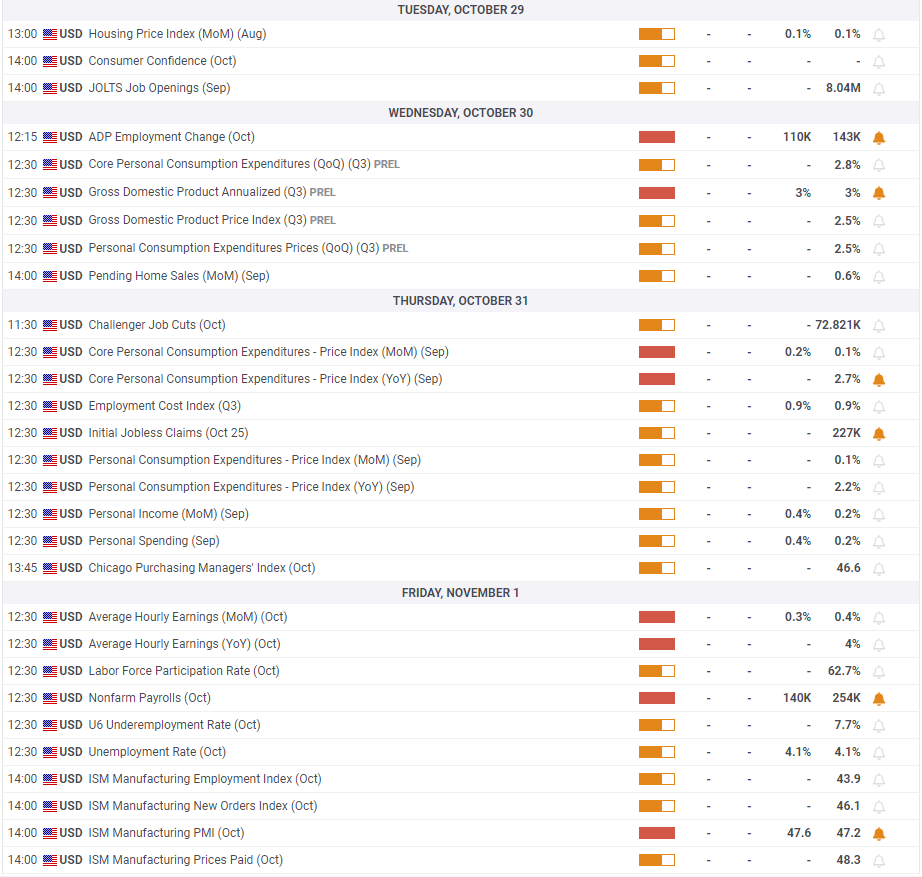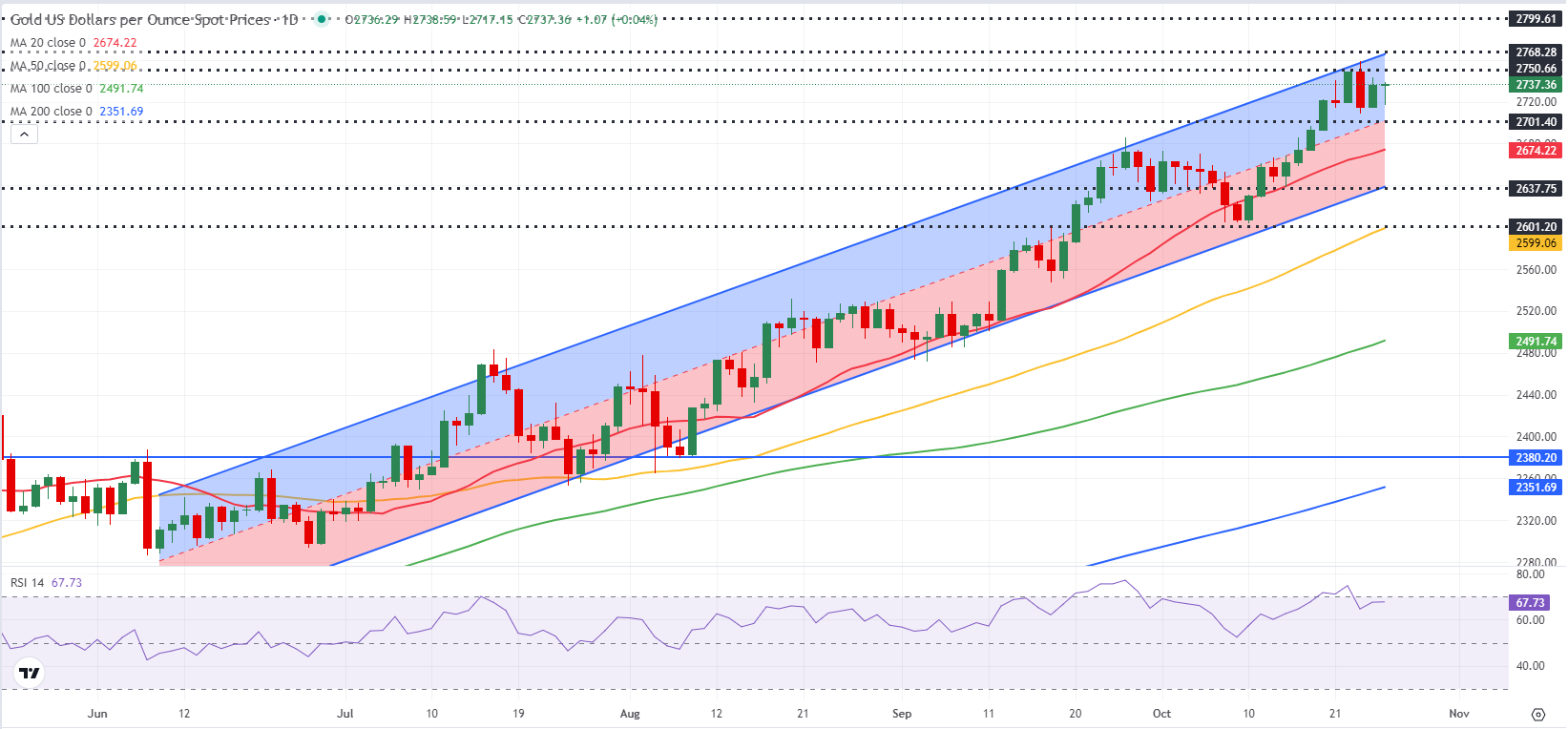- Gold corrected lower after touching a new all-time high at $2,758.
- The technical outlook suggests that the bullish bias remains intact in the near term.
- Next week’s economic calendar will feature key US data releases that could impact Gold’s valuation.
Gold (XAU/USD) extended its uptrend and reached a new all-time high above $2,750. Rising US Treasury bond yields and the improving risk mood, however, made it difficult for the precious metal to preserve its bullish momentum in the second half of the week. The US economic calendar will feature Gross Domestic Product (GDP) data for the third quarter and labor market figures for October, which could significantly affect Gold’s valuation next week.
Gold loses bullish momentum
Gold edged higher to start the week as the People's Bank of China’s (PBoC) decision to cut the one-year Loan Prime Rate (LPR) by 25 basis points (bps) from 3.35% to 3.10% eased concerns over an economic downturn. Additionally, escalating geopolitical tensions allowed the precious metal to capture safe-haven demand on Monday as markets reacted to reports of Hezbollah claiming responsibility for a drone attack that targeted Israeli Prime Minister Benjamin Netanyahu’s house over the weekend.
XAU/USD preserved its bullish momentum on Tuesday and gained more than 1% on the day. In the absence of high-tier data releases, Gold continued to benefit from the souring market mood. After reaching a new all-time high of $2,758 during the European trading hours on Wednesday, the precious metal reversed its direction and closed the day with a 1.2% loss. Rising US Treasury bond yields and the broad-based US Dollar (USD) strength caused XAU/USD to lose its footing midweek. Additionally, profit-taking after the record-setting rally may have ramped up the bearish pressure.
On Thursday, data from the US showed that the business activity in the private sector continued to grow at a healthy pace in early October, with the preliminary S&P Global Composite Purchasing Managers Index (PMI) edging higher to 54.3 in October from 54.0 in September. Assessing the survey’s findings, “October saw business activity continue to grow at an encouragingly solid pace, sustaining the economic upturn that has been recorded in the year to date into the fourth quarter,” said Chris Williamson, Chief Business Economist at S&P Global Market Intelligence and added: “The October flash PMI is consistent with GDP growing at an annualized rate of around 2.5%.” Gold struggled to gather recovery momentum after this report and ended the day modestly higher.
The market action turned choppy heading into the weekend and Gold spent Friday fluctuating in a relatively narrow range.
Gold investors gear up for key data releases
The US Bureau of Economic Analysis (BEA) will publish the first estimate of the annualized Gross Domestic Product (GDP) growth for the third quarter on Wednesday. Investors forecast the US GDP to expand by 3% in this period, matching the growth recorded in the second quarter. A reading above the market expectation could boost the USD as the immediate reaction and cause XAU/USD to stretch lower. On the other hand, a disappointing GDP print, between 1% and 2%, could hurt the USD.
On Thursday, the BEA will publish the Personal Consumption Expenditures (PCE) Price Index, the Federal Reserve’s (Fed) preferred gauge of inflation, for September. Because the GDP report will also offer quarterly PCE Price Index numbers, the monthly data is unlikely to trigger a market reaction.
The US Bureau of Labor Statistics (BLS) will release the labor market data for October on Friday. In September, Nonfarm Payrolls (NFP) rose by 254,000. This reading surpassed the market expectation of 140,000 by a wide margin and caused markets to refrain from pricing in a 50 basis points (bps) Fed rate cut in November.
According to the CME FedWatch Tool, markets nearly fully price in a 25 bps rate cut at the upcoming meeting and see about a 70% chance of the Fed lowering the policy rate by a total of 50 bps by the end of the year. At this point, it would take a significant downside surprise in NFP for markets to reconsider the possibility of a large rate cut either in November or December. In case the NFP comes in at or below 100,000, the USD could come under heavy selling pressure and open the door for a Gold rally heading into the weekend.
Conversely, an NFP print between 180,000 and 220,000 could be seen as a ‘good enough’ figure for the Fed to opt for two 25 bps rate cuts by the end of the year. Finally, investors could doubt a rate cut in December if the NFP arrives near 300,000 or higher. In this scenario, XAU/USD could come under strong bearish pressure.
Gold technical outlook
The Relative Strength Index (RSI) indicator on the daily chart retreated toward 60 after rising above 70 earlier in the week, suggesting that the bullish bias remains intact after Gold corrected its overbought conditions. Additionally, XAU/USD remains within the ascending regression channel coming from June.
Looking south, first support could be spotted at $2,700, where the mid-point of the ascending channel is located, before $2,675 (20-day Simple Moving Average) and $2,635 (lower limit of the ascending channel).
On the upside, interim resistance seems to have formed at $2,750 before $2,770 (upper limit of the ascending channel) and $2,800 (round level).
Gold FAQs
Gold has played a key role in human’s history as it has been widely used as a store of value and medium of exchange. Currently, apart from its shine and usage for jewelry, the precious metal is widely seen as a safe-haven asset, meaning that it is considered a good investment during turbulent times. Gold is also widely seen as a hedge against inflation and against depreciating currencies as it doesn’t rely on any specific issuer or government.
Central banks are the biggest Gold holders. In their aim to support their currencies in turbulent times, central banks tend to diversify their reserves and buy Gold to improve the perceived strength of the economy and the currency. High Gold reserves can be a source of trust for a country’s solvency. Central banks added 1,136 tonnes of Gold worth around $70 billion to their reserves in 2022, according to data from the World Gold Council. This is the highest yearly purchase since records began. Central banks from emerging economies such as China, India and Turkey are quickly increasing their Gold reserves.
Gold has an inverse correlation with the US Dollar and US Treasuries, which are both major reserve and safe-haven assets. When the Dollar depreciates, Gold tends to rise, enabling investors and central banks to diversify their assets in turbulent times. Gold is also inversely correlated with risk assets. A rally in the stock market tends to weaken Gold price, while sell-offs in riskier markets tend to favor the precious metal.
The price can move due to a wide range of factors. Geopolitical instability or fears of a deep recession can quickly make Gold price escalate due to its safe-haven status. As a yield-less asset, Gold tends to rise with lower interest rates, while higher cost of money usually weighs down on the yellow metal. Still, most moves depend on how the US Dollar (USD) behaves as the asset is priced in dollars (XAU/USD). A strong Dollar tends to keep the price of Gold controlled, whereas a weaker Dollar is likely to push Gold prices up.
Information on these pages contains forward-looking statements that involve risks and uncertainties. Markets and instruments profiled on this page are for informational purposes only and should not in any way come across as a recommendation to buy or sell in these assets. You should do your own thorough research before making any investment decisions. FXStreet does not in any way guarantee that this information is free from mistakes, errors, or material misstatements. It also does not guarantee that this information is of a timely nature. Investing in Open Markets involves a great deal of risk, including the loss of all or a portion of your investment, as well as emotional distress. All risks, losses and costs associated with investing, including total loss of principal, are your responsibility. The views and opinions expressed in this article are those of the authors and do not necessarily reflect the official policy or position of FXStreet nor its advertisers. The author will not be held responsible for information that is found at the end of links posted on this page.
If not otherwise explicitly mentioned in the body of the article, at the time of writing, the author has no position in any stock mentioned in this article and no business relationship with any company mentioned. The author has not received compensation for writing this article, other than from FXStreet.
FXStreet and the author do not provide personalized recommendations. The author makes no representations as to the accuracy, completeness, or suitability of this information. FXStreet and the author will not be liable for any errors, omissions or any losses, injuries or damages arising from this information and its display or use. Errors and omissions excepted.
The author and FXStreet are not registered investment advisors and nothing in this article is intended to be investment advice.
Recommended Content
Editors’ Picks

EUR/USD tumbles to three-week lows near 1.0750
Fresh headlines mentioning the imminence of US tariffs on the European Union put EUR/USD under heavy pressure and send it to the area of multi-week lows around 1.0750 on Wednesday.

GBP/USD retests the 1.2870 zone, or two-week lows
The Greenback's upside impulse is now gathering extra steam and motivates GBP/USD to recede to the area of new two-week troughs around 1.2870.

Gold remains slightly offered just above $3,000
Gold is trading in a narrow range on Wednesday but continues to hold firm just above the $3,000 mark. The precious metal is drawing support from upbeat sentiment in the broader commodities space, buoyed by Copper’s surge to a fresh all-time high earlier in the day.

Bitcoin holds $87,000 as markets brace for volatility ahead of April 2 tariff announcements
Bitcoin (BTC) holds above $87,000 on Wednesday after its mild recovery so far this week. A K33 Research report explains how the markets are relatively calm and shaping up for volatility as the market absorbs the tariff announcements.

Sticky UK services inflation shows signs of tax hike impact
There are tentative signs that the forthcoming rise in employer National Insurance is having an impact on service sector inflation, which came in a tad higher than expected in February. It should still fall back in the second quarter, though, keeping the Bank of England on track for three further rate cuts this year.

The Best brokers to trade EUR/USD
SPONSORED Discover the top brokers for trading EUR/USD in 2025. Our list features brokers with competitive spreads, fast execution, and powerful platforms. Whether you're a beginner or an expert, find the right partner to navigate the dynamic Forex market.

